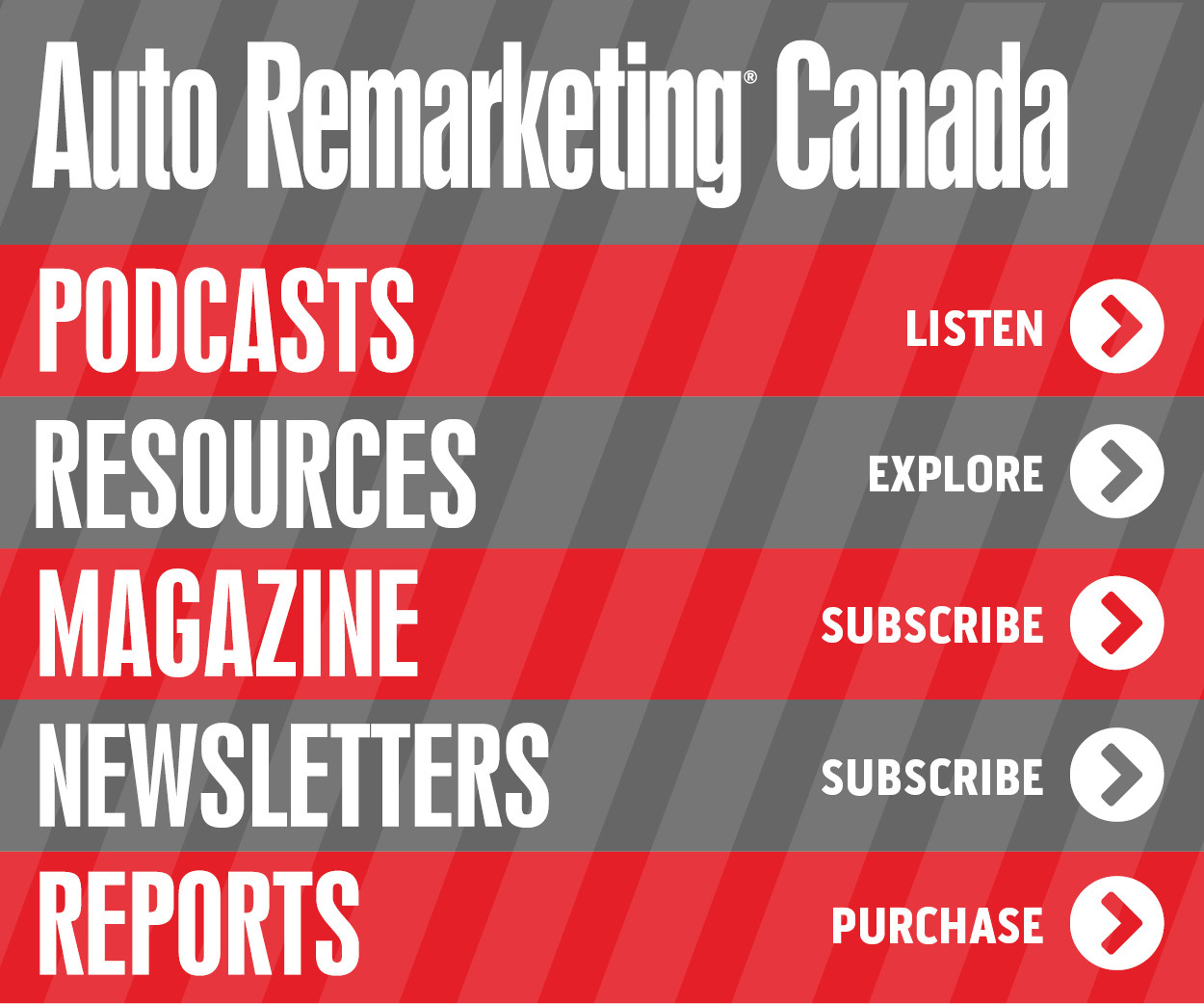Healthy auto finance market fueled by new tech, demand

Over the course of the pandemic, leasing fell way off, and the auto finance market saw loan-term lengths soar amid a difficult economic environment for consumers.
And it’s likely in Canada, the market may never return to the norm dealers have historically been used to.
The leasing fall out is tied to an evolving lender and bank market, as well as negative equity concerns.
Michael Buckingham, managing director auto finance at J.D. Power, spoke with Auto Remarketing Canada in early June.
Buckingham, who will lead the “Auto Finance Origination Trends and Insights” session next week at Canada’s Used Car Week, has been in the indirect auto industry for more than 30 years, and served as the president and CEO of Hyundai Capital America before joining J.D. Power in 2013.
The lending market is getting more competitive, and dealers are expecting more from their lender partners. And according to J.D. Power research released in March, brand loyalty is key to leasing success.
Finance companies need to focus on bringing their lease customers back to the brand in light of the current market. J.D. Power said lease options for customers are limited as leasing volume continues to fall.
According to the J.D. Power 2023 U.S. End of Lease Satisfaction Study, the key to attracting and retaining those customers is understanding when lessees make their decisions and how best to communicate with them at the right moment.
“In this market, lenders need to take actions that create and maintain brand loyalty,” J.D. Power director of automotive finance intelligence Patrick Roosenberg said in a news release announcing the study results. “Because there are fewer lease opportunities, the best course of action is for lenders to do everything in their power to maintain their current customers.”
According to J.D. Power data, the leasing mix in Canada has fallen from approximately 30% share of the auto market in 2019 to the low 20s in 2023, which is very similar to what the industry is seeing in the U.S., as well.
The lack of OEM leasing incentives is a big issue, said Buckingham.
“Incentives overall (lease, cash, low APR) have fallen dramatically in the past two years due to that lack of vehicle availability that was constrained by the chip and supplier shortages due to the restart from the pandemic,” he said.
There was more consumer demand than supply for many name brands, so reducing incentives was a no-brainer.
“With OEM production increasing and dealer inventories growing, we do see some OEMs that are directing incentives to leasing, and we think that we have hit bottom and the amount of leasing relative to loan will gradually increase,” Buckingham said.
What role does brand loyalty play in leasing success?
“Leasing can drive brand loyalty as the consumer generally has a vehicle that remains in the OEM warranty and in some instances free scheduled maintenance for the life of the lease,” Buckingham said. “OEM’s stay in contact during the lease and provide offers for a new lease through the lease cycle.”
Many consumers enjoy the convenience of a lease and tend to stick to the leasing market.
But for some of the younger lessors, “They look at vehicle leasing as a subscription product, with availability to upgrade down the road like their iPhone,” said Buckingham.
Auto-finance market healthy amid high demand
There continues to be pent-up demand for vehicles. But higher interest rates and the potential for a recession have put downward pressure on consumers looking for vehicles.
But Buckingham says the auto finance market is still healthy.
“Consumers’ balance sheets are still in a good position; delinquency and credit losses are still good; employment is good,” said Buckingham.
There has been some concern about used-car prices falling from unusual highs. But J.D. Power doesn’t see any major downward price adjustments, as the loss of new-vehicle sales in the past few years will keep used-car prices healthy.
Leasing trends are evident in the finance market, as well. According to Buckingham, the industry is seeing more loan financing and less lease deals — “but cars are still selling.”
“We do see slightly more cash transactions that are a byproduct of the higher financing rates,” he said.
As for lender and segment breakdown, “We’ve certainly seen the banks gain a little more market share in the last 18 months as a result of lenders doing less leasing,” said Buckingham.
There hasn’t really been any robust APR offers from the big-brand OEMs.
The industry is seeing this trend in the mainstream brands, and even in the luxury sector, as well.
“The independents (lenders) stay fairly stable, and the credit unions, unlike in the U.S., aren’t really a factor in the Canadian auto market,” Buckingham said.
For used cars, banks are dominant simply because the captives are not as aggressive on the used-car front.
“From a high-level drilling down, you have four or five big banks that are really driving the Canadian auto-finance business,” Buckingham said.
Lender partner expectations
It comes down to good service and speed in underwriting and funding.
Buckingham cited access to the lender’s staff, a lender’s willingness to assist the dealer as a partner, reasonable pricing and competitive financing programs as key components, as well.
Although the “core” of the lender/dealer relationship remains much the same, Buckingham said, “The technology that connects the dealers to the lenders, some lenders are inventing more and satisfying their dealers greater.”
Considering the headwinds of high interest rates and continued limited supply of new vehicles, recent J.D. Power data showed dealers are focused more on streamlining their business and “expect more from their lenders.”
The JD Power 2023 Canada Dealers Financing Satisfaction Study found that 40% of dealers may not be interested in an in-person visit from sales reps, but they expect each interaction and touchpoint with the lender to bring substantial value — whatever the channel of communication may be.
These expectations include reps explaining the lender’s risk appetite, so the dealer completely understands the provider’s buying parameters.
“Dealers are looking for the most effective use of their time, so interactions with lenders’ sales representatives need to be value-added whether that’s via phone, text, email or in-person,” said Roosenberg in a press release announcing the study.
“While many dealers still want in-person meetings, lenders should be mindful about their clients’ time and communications preferences. How they opt to interact with sales reps varies from dealership to dealership and should be taken into consideration. The underlying stance we hear from dealers is that each communication touchpoint must be value-add regardless of channel,” he said.
Kia Finance ranked highest in the captive prime segment, and in the non-captive prime segment, Scotiabank was tops. In the non-captive prime segment, TD Auto Finance topped the pack in the late-spring study.
Long-term loans down slightly
As for loan-term length, no big movement, but they are inching down, according to data cited by J.D. Power’s Buckingham.
“I would say we are seeing less 85 months and beyond loans, and more 84-month loans on average.”
Banks are responsible for the majority of 85-month and longer loans.
“What we’ve seen is the captives are picking up a bit of that share, because their APR programs are coming back, but when the captives do more, the term gets lower because their term lengths stop at 84 months.”
On the used-car side, loan-terms are shifting down, as well.
“When you put the two together, the buckets haven’t really moved that much, but it has lowered the average term slightly.”
And as aforementioned, the industry is seeing prices come down for new and used vehicles, which cuts down on the amount of money that needs to be financed over time.
Previously, the amount financed had been well above MSRP, but the industry is seeing advances now coming below MSRP, which really indicates that there are discounts beginning to come back into the market.
The industry is coming off of record high pricing, “and there is only one way to go from there,” says Buckingham.
Trade-in values remain strong on used and new vehicles, and that’s helping a lot in terms of consumers looking to get into a new vehicle.
“If you’ve got the ability to trade in a later model car, you’ve got some pretty strong equity,” said Buckingham.


